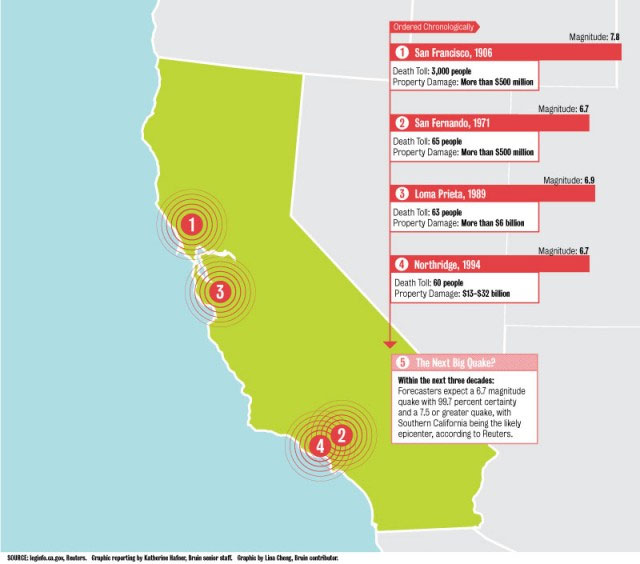Bill proposes earthquake early warning system

By Taylor Aquino
Feb. 6, 2013 1:41 a.m.
The graphic accompanying this article contained an error and has been changed. See the bottom of the article for additional information.
A California lawmaker recently proposed creating a statewide earthquake early-warning system to help prevent widespread damage to both people and property, and to alleviate the fiscal impact of future earthquakes on the state.
The last major earthquake to affect a large part of California occurred in 1994 and had a magnitude of 6.7.
Radiating out from Northridge, Calif., the temblor caused between $13 and $32 billion dollars in damage and led to about 60 casualties, according to Sen. Alex Padilla’s (D-Pacoima) bill.
Tremors from the earthquake were also felt on the UCLA campus and the resulting damages cost the university over $650 million in repairs, according to Daily Bruin archives.
A report by the Uniform California Rupture Earthquake Forecast in 2008 predicts a 99.7 percent chance of an earthquake of magnitude 6.7 or higher hitting California within the next 30 years, according to Padilla’s state senate bill.
The proposed alert system would be designed to identify waves that are associated with earthquake tremors.
Scientific tools embedded within the earth’s surface would generate a warning after identifying the waves, activating the system that would then alert civilians and emergency personnel up to 60 seconds before “potentially damaging ground shaking is felt,” according to Padilla’s website.
Civilians would be able to stop their vehicles or take cover or exit a building, and officials would potentially have time to power down trains and other “critical” infrastructure such as gaslines and aquaducts, according to the proposal.
One of the ways the system would alert civilians would be through a text notification system.
Countries such as Japan, Mexico, Romania and China already have, or are in the process of creating, similar systems. In California, the system would cost at least $80 million in state funds and would take two years to complete.
The state would need to augment its already existing network of earthquake sensors, according to Padilla’s website.
Southern California is a particularly dangerous zone, because more than 50 percent of the nation’s earthquake risk is contained in the eight counties that make up the region, said Debbie Weiser, a graduate student in geology and a part-time employee of the U.S. Geological Survey.
The organization is currently working with UC Berkeley and Caltech to develop the earthquake alert system Padilla proposed in his bill.
Los Angeles, specifically, is in a very susceptible location because the sediments in the area’s basin are very loose, he said.
A major earthquake from either the south or the north would cause a significant amount of damage, said Edward Rhodes, a UCLA professor of earth and space sciences.
Rhodes said an earthquake alert system would be beneficial because it would help ensure safety.
“When earthquake waves come along … they’re a bit like jelly,” Rhodes said. “What that means is the shaking is worse and goes on for longer.”
He said he thinks people in Southern California are typically less prepared than they should be, given the risk of earthquake damage in the region.
Departments on campus have their own procedure to follow if there is an earthquake in the area, said Jesse Miller, the emergency management specialist at UCLA’s Office of Emergency Management.
UCLA also has a text messaging system, commonly referred to as BruinAlert, that sends students messages in the event of an on-campus incident.
In the event of an earthquake, the messages would be generated after the quake and would focus on response rather than warnings.
“(Students) need to know emergency plans for buildings that they frequent and their dorms and apartment buildings,” Weiser said.
Students should stock up to two weeks of supplies with them in case of an emergency, Weiser said.
“There will be big events. It’s not as if there’s possibility that they won’t happen,” Rhodes said.
“They will definitely happen, we just don’t know exactly when and where. And the more prepared we are, the quicker California will return to normality and economic productivity.”
The bill will need to pass by a majority vote in the state legislature to go in effect.
Correction: “Loma Prieta” was misspelled in the graphic.


